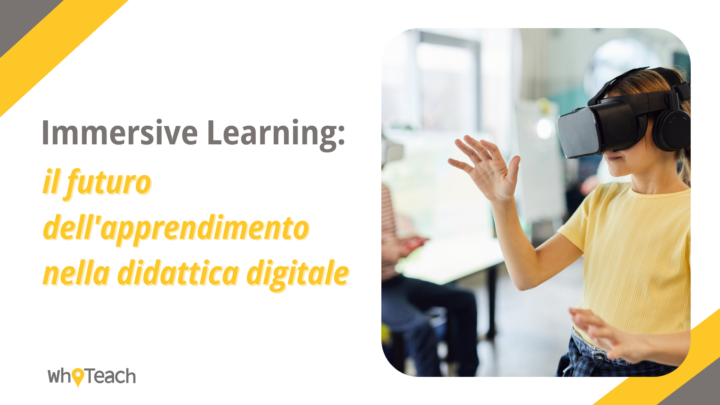A survey conducted by Harvard Business Review revealed that 75% of workers state that smartphones and other digital devices are the main source of distraction in the workplace. We are now surrounded by technology, and our concentration has significantly decreased. This has negative consequences on learning experiences as well, threatening our ability to assimilate and retain information. In a technology-dominated context, traditional learning risks no longer being engaging enough to maintain attention over the long term.
In response to this challenge, the EdTech sector, which integrates digital technologies into education, is experiencing rapid expansion. Among the various innovations, one of the most promising is immersive learning, an approach that combines the physical world with virtual environments to create engaging and interactive learning experiences.
In this article, we at WhoTeach will explain what this tool is and its importance within a digital learning platform like ours.
Immersive Learning: Definition and What It Consists Of
Immersive learning is an innovative training approach that combines the real world with virtual environments to create engaging, interactive, and customizable learning experiences.
This method is made possible through the use of an avatar, a digital representation of oneself, which interacts in virtual spaces that perfectly replicate reality. This creates an “on-the-job” experience in full safety without the need for transfers or laboratory costs. This process stimulates attention, activates the senses, and promotes more participatory and accessible learning. As a result, learning is no longer passive and lecture-based but becomes active because the individual independently creates their own path.
Immersive learning allows individuals to experiment, make decisions, and make mistakes in a safe environment, thereby developing practical skills and strengthening the understanding of complex and abstract concepts. In this sense, immersive experiences are particularly relevant in training and learning paths related to high-risk sectors such as the medical and healthcare context. For example, at the Department of Clinical and Biological Sciences of the University of Turin, the Immersive Interactive Room was created: a multisensory environment that allows for the realistic simulation of complex medical scenarios. The project includes an interactive room with a floor that generates vibrations, simulators of atmospheric events, a sound system that reproduces ambient noises, and laser projectors that transform the walls into interactive touch screens. This immersive room serves as both a learning space and a safe environment for experimentation where mistakes can be made without real consequences.
Tools for Creating Immersive Learning
Thanks to advanced technologies, students can interact with 3D models, realistic simulations, and scenarios that replicate real-life situations.
The most commonly used tools in immersive learning are:
- Virtual Reality: use of VR headsets to create and access virtual environments.
- Augmented Reality: introduction of virtual elements into real spaces, such as reproducing objects in a home setting.
- Video Simulations: creation of realistic scenarios through interactive videos.
- Artificial Intelligence: creation of a virtual tutor that guides participants through the training course.
Platforms like WhoTeach leverage some of these tools to provide participants with highly interactive and customizable training courses.
Benefits of Immersive Learning
The benefits that the immersive learning approach can bring to training and learning are numerous.
- Students train in a hyper-stimulating environment where emotional, relational, and cognitive engagement is maximized. This means maintaining high concentration and facilitating the retention of acquired knowledge. Additionally, the virtual space allows for potentially infinite repetitions of exercises without consequences, reinforcing the memorization of procedures.
- In traditional learning contexts, students often work at a speed or level that is not suitable for them. Some may find it too slow and lose interest, while others may struggle to keep up. Immersive learning presents itself as an effective solution as it allows content to be adapted to the student’s needs and abilities.
- Immersive learning also enables the collection of important data that is more difficult to obtain traditionally. For example, it allows for tracking access frequencies and training duration; attention levels, results and performance, and participant feedback. Additionally, predictive analyses can be conducted to create content adaptable to reality.
An example of these benefits can be found in Newton, an ecosystem that creates generative experiences for business, which has developed immersive learning experiences. Through virtual simulations and game elements, it has sought to improve skills and decision-making. Among its most notable projects in this area are “The Cage” and “SHED65,” which have improved learning effectiveness, with retention increasing by up to 75% compared to traditional methods.
Conclusions
Immersive learning is emerging as one of the most promising methodologies for revolutionizing the world of education and training. Thanks to new technologies, it is possible to create dynamic, interactive, and customizable learning environments capable of maintaining high student attention and improving their ability to assimilate knowledge. This approach not only makes learning more effective and engaging but also offers new opportunities to develop practical skills in safe and controlled contexts.
Platforms like ours at WhoTeach are at the forefront of the possible integration of these educational technologies. With the continuous development of the EdTech sector and the support of government initiatives, immersive learning is set to play a key role in the education of the future, helping to train more prepared and competent generations.




